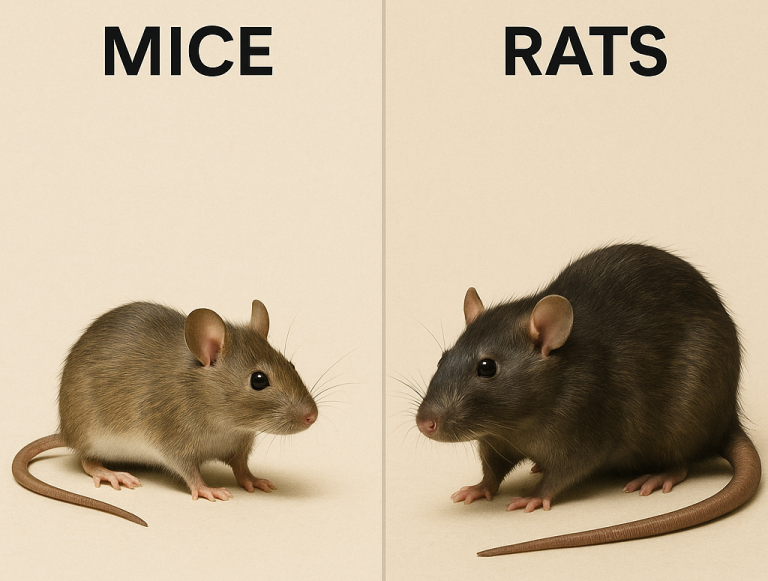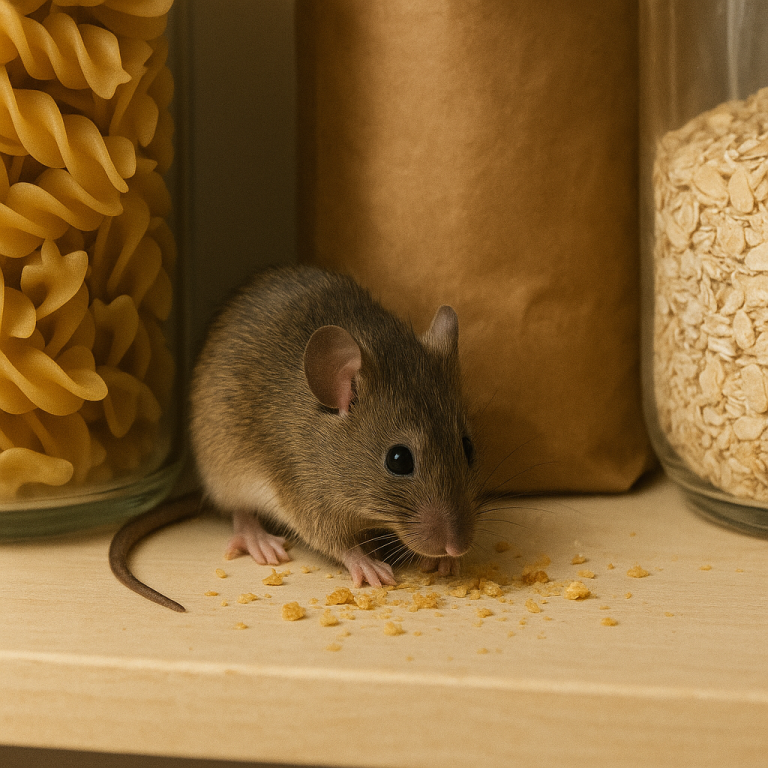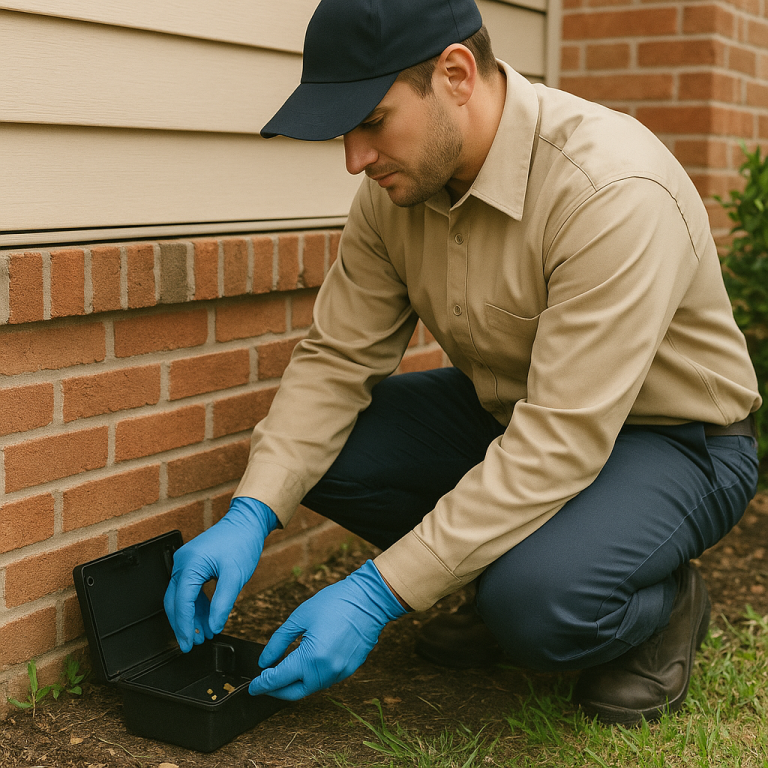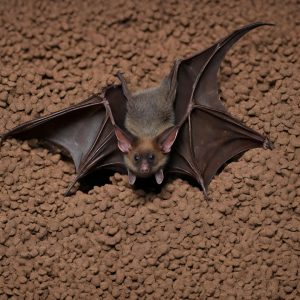Mice vs Rats: How to Tell Which One You Have
Finding droppings in your kitchen or hearing scratching noises in your walls can be unsettling, but knowing what you’re dealing with is the first step toward solving the problem. In Hamilton and other Southern Ontario cities, homeowners often struggle to tell whether they have mice or rats. While both are rodents, they behave differently, require different control strategies, and leave behind distinct clues.
This guide explains how to tell the difference between mice and rats, what signs to look for in your home, and why correct identification is key to effective pest control.
Why It’s Important to Know the Difference
Mice and rats may look similar, but they differ in size, nesting habits, and behavior. The treatment methods that work for mice won’t necessarily work for rats. For instance, a small trap that’s effective for a house mouse might not even attract a Norway rat.
Rats are also more cautious and intelligent than mice, meaning they often avoid unfamiliar objects or traps. Mice, on the other hand, are more curious and will explore new food sources or objects more quickly.
Understanding which species is in your home helps pest control technicians choose the right placement, bait and sealing techniques, saving you time, stress, and money.

Physical Differences Between Mice and Rats
If you’ve seen one of the intruders, even briefly, there are clear physical traits that can help you tell them apart.
Size and Shape
- Mice are small, typically 5 to 7 inches long including their tails. Their bodies are slender, and their heads are proportionally small.
- Rats are much larger, 12 to 18 inches long including their tails. They have thicker bodies, blunt snouts, and heavier builds.
Tails
- Mice have long, thin, slightly hairy tails.
- Rats have thicker, scaly, almost hairless tails.
Ears and Eyes
- Mice have large ears and eyes relative to their head size.
- Rats have smaller ears and eyes that appear more proportionate to their larger heads.
Droppings
- Mouse droppings are small, about the size of a grain of rice, and pointed at both ends.
- Rat droppings are larger, about ¾ inch long, and more rounded or blunt.
Spotting droppings is often the first clue homeowners notice, and examining their size and shape can quickly help you determine which pest you’re dealing with.
Behavioural Clues: How Mice and Rats Act Differently
Even if you never see the pests themselves, their behaviour leaves behind telltale signs.
Movement and Travel Patterns
- Mice are curious explorers. They travel shorter distances, usually within 10–25 feet of their nests, and frequently investigate new objects.
- Rats are cautious and territorial. They travel further, sometimes over 100 feet from their nesting site, but they follow the same routes repeatedly along walls and baseboards.
If you notice greasy rub marks along walls or baseboards, that’s often a sign of rat activity. Their oily fur leaves behind residue as they travel the same paths.
Noise Levels
Both rodents are nocturnal, but rats make louder and slower scratching or gnawing sounds compared to the quick, light pitter-patter of mice.
If you hear heavy movement or gnawing at night, particularly in the attic, ceiling, or behind walls, it’s likely rats.
Nesting Habits
- Mice build nests out of shredded paper, fabric, or insulation, usually close to food sources (like under kitchen appliances or inside wall voids).
- Rats prefer secluded nesting areas such as basements, crawl spaces, and attics. Some species, like Norway rats, dig burrows outdoors under decks or foundations.
Finding a nest often indicates a long-term problem, as these pests reproduce quickly once established indoors.

Signs of an Infestation
Knowing how to read the evidence is essential. Here are key indicators that can help you identify which rodent is invading your home.
Droppings
As mentioned earlier, the size and shape of droppings are the easiest way to differentiate between mice and rats. Check along baseboards, behind appliances, and near food storage areas.
Gnaw Marks
Both species chew constantly to keep their teeth from overgrowing.
- Mice leave smaller, finer chew marks.
- Rats leave larger, rougher gnaw marks, sometimes on wood, wires, or plastic containers.
Odour
A strong, musky odour is a sign of a heavy mouse infestation. Rat infestations, especially in basements or attics, produce a stronger, ammonia-like smell.
Footprints and Smudge Marks
Rats, in particular, leave greasy smudge marks along their travel paths due to the oils in their fur. You may also find small footprints or tail marks in dusty areas.
Burrows or Entry Points
- Mice can squeeze through openings as small as a dime.
- Rats need slightly larger openings, about the size of a quarter.
Check along foundations, vents, and utility lines for chew holes or disturbed insulation.
Health and Property Risks
Rodents are more than just a nuisance. They pose real health and safety risks.
Disease Transmission
Both rats and mice can spread diseases like salmonella, hantavirus, and leptospirosis. Their droppings and urine contaminate surfaces and food storage areas, putting your family at risk.
Allergies and Asthma
Rodent droppings and dander can trigger allergic reactions, especially in children and pets.
Fire Hazards
Rodents often chew through electrical wiring, which can cause short circuits or house fires. This is particularly dangerous in attics and walls where wiring is hidden.
Structural Damage
Rats, being stronger chewers, can gnaw through wood, insulation, and even some metal. Over time, this can lead to costly repairs.
What Causes Rodent Infestations in Hamilton Homes
Hamilton’s climate and geography make it particularly susceptible to rodent problems. Cold winters drive mice and rats indoors, while the city’s combination of older homes and natural green spaces creates ideal nesting opportunities.
Common Contributing Factors
- Cracks in old brick foundations
- Gaps under garage doors or siding
- Poorly sealed vents or utility lines
- Accessible pet food or bird seed
- Cluttered basements or storage areas
The best prevention strategy involves eliminating entry points and food sources before rodents have a chance to move in.
Prevention Tips: Keeping Mice and Rats Out
Seal Entry Points
Inspect your foundation, attic, and around pipes. Use steel wool and caulking to fill holes, and install door sweeps to block gaps under doors.
Store Food Securely
Keep dry goods in airtight containers and clean up crumbs or spills promptly. Pet food should also be stored in sealed bins.
Declutter Storage Areas
Rodents thrive in cluttered spaces where they can hide. Keep basements, garages, and attics organized and off the floor.
Trim Vegetation
Cut back tree branches and shrubs that touch your roofline or siding. These act as bridges for rats and squirrels.
Schedule Regular Inspections
Even if you don’t see signs of activity, professional inspections help catch early evidence before an infestation grows.

Professional Rodent Control in Hamilton
While traps and DIY methods can help with small problems, a professional pest control technician provides a long-term solution.
At Elite Pest and Wildlife Removal, our technicians start by identifying the species, assessing entry points, and developing a customized plan. This may include:
- Strategic placement of tamper-resistant bait stations
- Sealing and exclusion of entry points
- Sanitation and odour control measures
- Follow-up visits to monitor results
Our team serves Hamilton, Stoney Creek, Ancaster, Burlington, Oakville, and surrounding areas, specializing in safe, effective rodent control for both residential and commercial properties.
Know What You’re Dealing With Before It Grows
Whether it’s mice nesting in your kitchen or rats tunneling near your foundation, identifying the problem early is the best way to stop it from spreading. Both rodents are intelligent and adaptable, but their habits differ enough that proper identification is the key to success.
Don’t wait around if you hear scratching, finding droppings, or notice chew marks around your home. Call 226-208-7793 or visit elitepestandwildlife.ca to schedule your rodent inspection.


